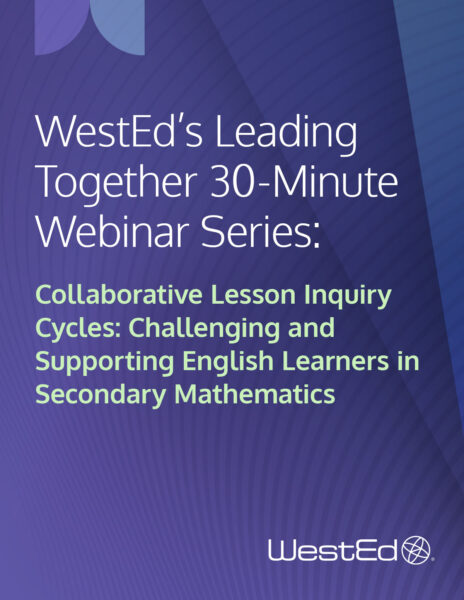
October 15, 2025
WestEd’s recent Leading Together webinar explored how collaborative lesson inquiry cycles expand teacher expertise and support English Learners in secondary mathematics classrooms.
Led by Haiwen Chu, research director for the English Learner and Migrant Education team at WestEd, and Monique Evans, program associate for the same team, the session demonstrated how structured teacher collaboration can transform instructional practice.
The Importance of Teacher Expertise in the Collaborative Lesson Inquiry Cycle
The collaborative lesson inquiry cycle focuses on the combination of knowledge, practice, and reflection. Reflection serves as the main vehicle for teacher learning.
“Reflection is going to be the main vehicle through which teacher learning happens. It happens before they teach, as they plan. It happens as they teach, as they adjust,” Chu explained. “It happens after they teach, as they look back and begin to understand what worked for whom and why and under what conditions.”
Additionally, for these cycles to succeed, educating English Learners must be viewed as a team effort rather than the responsibility of one specialist. Teams of teachers work together to use the same strategies and tools. They plan lessons, assess student talk and thinking, and adjust instruction collectively.
How Do Collaborative Lesson Inquiry Cycles Work?
Collaborative lesson inquiry cycles, or CLICs, are based on the Japanese lesson study model. A team of four to six teachers works with a facilitator coach over 2 days.
On Day 1, teachers develop a focus for observation and planning. One common focus is quality talk—moving from typical classroom interactions in which students report understanding they’ve already achieved to quality interactions in which students think through speech, explore ideas in depth, and build upon one another’s ideas.
Teachers then identify lesson goals, including conceptual understanding, mathematical practices, and language practices. They design the lesson flow and develop student-facing materials. Before Day 1 concludes, teachers rehearse the lesson, with one or two teachers teaching it to the rest of the team to identify needed revisions.
On Day 2, the lesson is taught twice. The team splits into Team A and Team B. Team A implements first while Team B observes students—not teachers—looking for evidence of quality talk. Each observer sits with a pair or small group and follows them throughout the lesson, transcribing what students say and do without interference or judgment.
After the first implementation, teams debrief together. The observing team shares evidence of student talk first; then implementing teachers share impressions. The group decides what needs revision to provide more opportunities for quality talk. After refining the lesson, teams switch roles. Team B implements while Team A observes, followed by another debriefing session. Each teacher names something they learned and the next step for their practice.
What Is the Impact of Collaborative Lesson Inquiry Cycles on Teacher Practice and Student Learning?
Teachers shared collective lessons learned at the end of the cycle, and many described shifts in their thinking, wanting to move away from telling or modeling rote procedures toward supporting students in making sense of ideas. For example, one teacher wanted to move away from assigning individual worksheets and instead structure tasks that invite collaboration and co-construction of understanding. Teachers also wanted to shift from prioritizing completion and compliance to prioritizing conceptual focus and deep understanding.
Through collaborative lesson inquiry cycles, teachers plan together, implement with students, and reflect to challenge and support English Learners in their classrooms.
Watch the full webinar and view other webinars in the Leading Together series.
How WestEd Can Help
Learn more about WestEd’s work in English Learner and Migrant Education, supporting schools, districts, and states to promote success and enhance learning opportunities for English and Multilingual Learners and migratory students.










